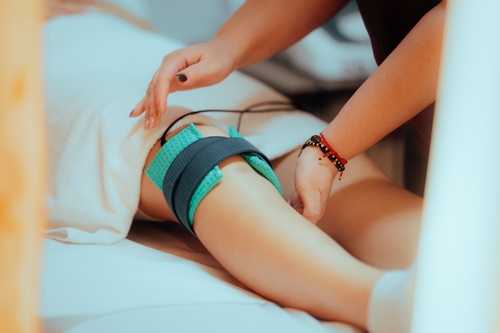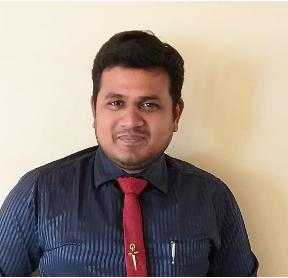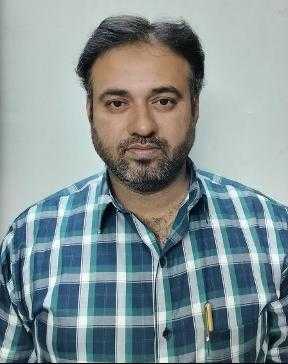
Expert Physiotherapy at Home
Certified physiotherapists visit you at home to provide focused, one-on-one care tailored to your needs. With no travel or waiting rooms, recovery happens in a setting that is comfortable, familiar, and built around your convenience.
Personalised Recovery Programmes
Every treatment plan is designed to suit your condition, goals, and pace. Our physiotherapists follow structured, evolving protocols to ensure consistent progress, with each session aligned to deliver meaningful results.
Trusted Physiotherapists. Real Results.
Our team comprises experienced, background-verified physiotherapists trusted by thousands of families. With a strong focus on safety, reliability, and clinical outcomes, we make recovery at home both effective and reassuring
Patient Testimonials
Portea Physiotherapists for Home Visits
Meet some of our experienced and dedicated healthcare professionals

Dr. Lokesh G
Physiotherapist
Specializations
Experienced in Neurological rehabilitation, Orthopaedic physiotherapy, and Paediatric care
Delivers structured, high-impact treatment plans across neuro, ortho, and paediatrics—ensuring safety, comfort, and measurable recovery at every stage.

Dr. Mohammed Sarwar
Physiotherapist
Specializations
Experienced in Neurological rehabilitation, Adult physiotherapy, and Paediatric care
Combines deep clinical expertise with a compassionate approach, supporting both adults and children through neuro and physical rehabilitation that promotes long-term independence and recovery.

Dr. Nelapati Divya
Physiotherapist
Specializations
Skilled in Orthopaedic rehabilitation, Manual therapy techniques, and Paediatric physiotherapy
Brings a personalised, hands-on approach to healing—combining structural expertise with paediatric sensitivity to restore movement, relieve pain, and improve everyday function.

Dr. Naveen V
Physiotherapist
Specializations
Trained in Pain management, Cardiac and Orthopaedic rehabilitation, Neurological care, and Neural tissue mobilisation
Brings clinical precision and empathy together—designing science-backed recovery protocols for pain relief, nerve mobilisation, and cardio-neuro-ortho rehabilitation across all age groups

Dr. Miloni Savla
Physiotherapist
Specializations
Holds an MPT in Orthopaedics with a focus on Musculoskeletal rehabilitation and strength recovery
Delivers focused, movement-oriented therapy grounded in orthopaedic science—helping patients rebuild strength, restore function, and return to daily life with confidence
Other Cities
Physiotherapy Treatments

short wave diathermy in physiotherapy
Short wave diathermy (SWD) is a therapeutic modality widely used in physiotherapy to treat musculoskeletal disorders and promote healing. It uses high-frequency electromagnetic energy to generate deep tissue heat, helping reduce pain, improve mobility, and accelerate recovery. If you’re seeking relief from chronic joint pain or recovering from an injury, SWD physiotherapy offers a non-invasive and effective treatment option.
role of shortwave diathermy (swd) in physiotherapy treatment
SWD in physiotherapy plays a critical role in managing pain, reducing inflammation, and enhancing the healing of soft tissues. It is commonly integrated into treatment plans for patients with arthritis, sprains, strains, and chronic muscle pain.
The diathermy machine delivers electromagnetic waves at high frequencies (usually 27.12 MHz), generating heat in the deep tissues without directly heating the skin. This heat promotes blood flow, loosens tight muscles, and reduces joint stiffness.
Physiotherapists use short wave diathermy as part of a holistic rehabilitation plan, often alongside manual therapy, exercises, and other electrotherapy techniques. Its ability to reach deep muscle layers makes it especially useful for treating conditions that don’t respond well to surface-level therapies.
By targeting deeper tissues, physiotherapy SWD not only relieves pain but also supports tissue repair, making it a valuable tool in recovery and the management of chronic pain.
how shortwave diathermy (swd) affects muscles and joints
SWD therapy works by producing deep heat within muscles and joints. When applied to the body, the electromagnetic waves penetrate deep into the tissues, causing molecules to oscillate and generate internal heat. This heat causes several beneficial physiological effects:
- Increased Blood Circulation: Enhanced flow delivers oxygen and nutrients to the affected area.
- Reduced Muscle Spasms: The warmth helps relax tight or injured muscles.
- Accelerated Healing: Improved circulation and cellular activity promote faster tissue repair.
- Pain Relief: Heat reduces pain signals and improves joint flexibility.
SWD work is especially beneficial for treating soft tissue injuries, such as ligament sprains, tendonitis, bursitis, and chronic muscle pain. It also plays a role in managing post-operative stiffness and edema.
This modality offers a comfortable experience for the patient while delivering profound therapeutic effects, especially in cases where deeper tissues are affected.
understanding swd machine settings and frequency
A SWD physiotherapy machine typically includes key components like electrodes (capacitive or inductive), power settings, timers, and frequency controls.
SWD frequency is usually standardised at 27.12 MHz, which is optimal for deep tissue penetration. The machine may offer pulsed or continuous modes:
- Continuous SWD: Delivers uninterrupted energy, suitable for chronic conditions requiring deep heating.
- Pulsed SWD: Delivers energy in intervals, reducing the thermal effect and suitable for acute inflammation.
The physiotherapist adjusts settings based on:
- Tissue depth and type being targeted
- Patient’s sensitivity and skin condition
- Treatment goals — whether reducing inflammation or increasing mobility
Proper SWD machine calibration and electrode positioning are essential to ensure safety and effectiveness during therapy. A well-trained therapist will select the mode and duration based on the individual patient’s needs and clinical indications.
when to use shortwave diathermy (swd) in clinical practice
Understanding the SWD indications helps physiotherapists determine when this therapy is most beneficial. Short wave diathermy (SWD) is primarily used for conditions that involve deep tissue pain, inflammation, and stiffness. It is highly effective in musculoskeletal rehabilitation due to its ability to deliver deep heat to muscles, joints, and ligaments.
Common indications of SWD include:
- Osteoarthritis and Rheumatoid Arthritis: Reduces joint stiffness and pain.
- Frozen Shoulder: Helps restore mobility by loosening tight tissues.
- Muscle Spasms and Strains: Relaxes muscles and improves circulation.
- Tendinitis and Bursitis: Decreases inflammation in affected areas.
- Chronic Back and Neck Pain: Provides deep, soothing heat for long-term relief.
- Post-surgical Stiffness or Edema: Aids in recovery and reduces swelling.
The range of SWD physiotherapy uses makes it a valuable tool in both acute and chronic care settings. Its non-invasive nature and effective pain-relief mechanism enable therapists to use it safely in conjunction with exercise, manual therapy, and other modalities in personalised treatment plans.
swd applications for joint, muscle, and nerve pain
Short wave diathermy uses extend to a wide range of physical conditions:
- Frozen Shoulder: Reduces joint stiffness and pain for better movement.
- Lower Back Pain: Helps relax muscle spasms and relieves lumbar stiffness.
- Knee Pain: Assists in managing osteoarthritis or ligament strain.
- Post-Injury Swelling: Reduces inflammation and supports the healing process.
- Sciatica and Nerve Pain: Provides deep heat to alleviate radiating nerve pain.
Diathermy physiotherapy is ideal for patients seeking drug-free, non-invasive alternatives to manage chronic and acute musculoskeletal discomfort.
electrode placement methods in swd therapy
Proper SWD electrode placement is essential for optimal therapy outcomes. Electrodes can be applied using two primary techniques:
- Capacitive Method: Electrodes are placed on either side of the treatment area, ideal for superficial tissues like muscle.
- Inductive Method: A coil or drum applicator is used for deeper tissues, like joints and large muscle groups.
Correct SWD placement ensures that electromagnetic energy reaches the targeted tissue. The physiotherapist carefully selects the size, shape, and distance of electrodes based on:
- Target tissue depth
- Size of the treatment area
- Desired heating effect
Precise positioning not only enhances treatment but also minimises side effects or discomfort.
safety precautions and contraindications of swd
While SWD therapy is generally safe, it must be used with caution. There are several contraindications of SWD where therapy should be avoided:
- Pregnancy: Not to be applied near the abdomen or pelvis.
- Metal Implants: Risk of overheating due to metal conduction.
- Pacemakers or electronic implants
- Open wounds or infected areas
- Active bleeding or cancerous tissue
SWD physiotherapy side effects may include mild skin redness, overheating sensation, or a temporary increase in pain if improperly used. Certified physiotherapists always assess for risk factors before starting treatment.
Adhering to strict guidelines ensures that every patient receives safe and effective diathermy physiotherapy.
benefits of using shortwave diathermy (swd) for recovery
Short wave therapy offers several clinically proven benefits in physical rehabilitation:
- Deep Tissue Healing: Stimulates cellular repair and regeneration.
- Pain Reduction: Soothes nerve endings and reduces inflammation.
- Non-Invasive: No needles, medication, or surgical procedures involved.
- Improved Mobility: Relaxes stiff muscles and improves joint range of motion.
- Faster Recovery: Accelerates healing in post-surgical or injury recovery.
SWD physiotherapy benefits make it a preferred choice for people with chronic pain, sports injuries, and post-operative discomfort. It’s a gentle yet effective therapy that delivers lasting results.
faqs on shortwave diathermy
1. Is short wave diathermy safe for everyone?
No, it should be avoided in pregnancy, over metal implants, or if you have a pacemaker.
2. How does short wave diathermy relieve pain?
It increases blood flow, relaxes muscles, and reduces inflammation, which collectively help relieve pain.
3. Can SWD be used for back and knee pain?
Yes, SWD is effective in relieving chronic back and knee pain by targeting deep tissues.
4. How long does a typical SWD session last?
An SWD session typically lasts between 15 to 30 minutes, depending on the condition.
5. How is the SWD machine adjusted during treatment?
The physiotherapist sets the frequency, mode (pulsed or continuous), and electrode placement based on your diagnosis.
Doctor Consultation
Nursing
Physiotherapy
Trained Attendant
Elder Care
Mother & Baby Care
Lab Tests
Medical Equipment
Speciality Pharma
Critical Care




